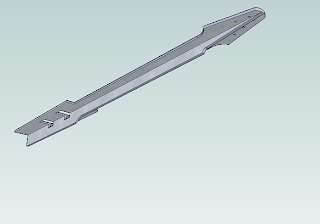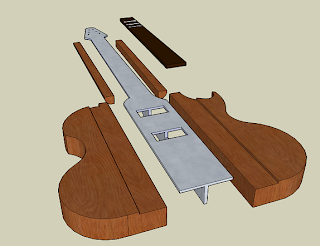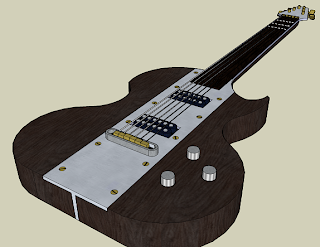One of the first ideas was to mount traditional tuners at the bottom as shown in my previous post "The Ergonomic Guitar". To make room for them all - plus the fingers when tuning - the bottom end of the guitar would have to be cut at a quite steep angle. That actually looks quite good and fits well with the idea, that the body should support the right arm (assuming you're right-handed). The T-beam can extend into the upper wing in an elegant way.
Unfortunately, the angle of the end of the T-beam had to be *very* steep to allow for room for all the tuners. An alternative would be to use string trees to guide the strings to each tuner - the strings would then spread out from behind the bridge as they do at e.g. the Kramer Duke (which happens also to be an aluminium guitar with the neck going all the way through).
To get a cleaner look and ensure sufficient downwards pressure on the saddles, one could improve this design by letting the strings dive down behind the saddles and continue on the backside of the guitar on to the tuners. To avoid to much friction when tuning, it would probably be necessary to use a very slippery material for saddles and for the material on the bottom, on which the strings rest.

On the picture, you can see that I chose to let the saddles rest directly on top of the T-beam instead of on a bridge plate. I assume it will improve sustain.
On Building the Ergonomic Guitar, a couple of headless guitars using Steinberger Gearless tuners have been described. Todd Keehn and Scott French have used them. Unfortunately, they both mount the tuners the way they're intended, meaning that the strings run on top of the guitars and into the tuners. That means that you'd have to reach to the back of the guitar and feel your way to the tuner in question. It works fine on a traditional guitar where the tuners are mounted on the guitar's head, but for a headless guitar, I believe it is not very practical.
If the Steinberger gearless tuners were mounted upside-down and the strings were routed below the surface of the T-beam (as in the earlier described idea with traditional tuners), the knobs would be on top of the guitar where you could see them. That would make for a clean design and improved usability.

The picture above shows the guitar (without the wings) using this configuraion. Furthermore, the separate saddles are replaced by a custom cut one-piece bridge made from TremNut or a similar low-friction material. That means that the bridge has a fixed intonation like the Les Paul Junior bridge and those on some PRS guitars. I like the idea of these bridges: The less separate parts, the better sound.
Besides Building the Ergonomic Guitar, The Project Guitar site - and especially the forum - has been a great source of inspiration and information. On the forum, a number of alternatives to traditional headless bridge/tuner combinations have been proposed. Among these, there were two, which I found especially interesting.
One of the regular posters had made his own tuners with separate saddles for a bass. With a little modification, this principle lends itself very well to the aluminium T-profile: You can mill six grooves for the tuners and saddles in the top flange of the T-beam - as shown in the picture below.

The knobs are in two planes, as this allows for bigger knobs and therefore easier tuning than if they'd all been in-line. That would be a really nice way of taking care of tuning. Unfortunately, I have almost no experience in metalworking (cutting the T-beam into shape is in itself a daunting task), so this idea will have to wait for later.
Another of the regulars at Project Guitar had used the Schaller 456 fine-tuning bridge for a headless travel guitar. The fine-tuners can't go very far, but he uses a string-mounting procedure with a pair of pliers and a locking nut, ensuring a sufficiently precise tuning when tightening the string with the pliers. The fine-tuners do the rest of the job. I've settled for this solution for the prototype of the T-beam, as it involves relatively little and uncomplicated metalworking as compared to the other solutions.
A very rough sketch looks like this:

I've bought the bridge (as well as some other components), so now that's settled. At least for the prototype. I'm especially keen on trying the Steinberger Gearless/TremNut fixed-intonation bridge combo on a later version. But as this is my first guitar project, I want to reduce the number of things that can go wrong, and the Schaller fine-tuning bridge offers a proven combination of bridge and tuning.




